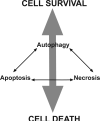Apoptosis and autophagy: regulatory connections between two supposedly different processes
- PMID: 17990121
- PMCID: PMC2601595
- DOI: 10.1007/s10495-007-0154-9
Apoptosis and autophagy: regulatory connections between two supposedly different processes
Abstract
Apoptosis and autophagy are genetically-regulated, evolutionarily-conserved processes that regulate cell fate. Both apoptosis and autophagy are important in development and normal physiology and in a wide range of diseases. Recent studies show that despite the marked differences between these two processes, their regulation is intimately connected and the same regulators can sometimes control both apoptosis and autophagy. In this review, I discuss some of these findings, which provide possible molecular mechanisms for crosstalk between apoptosis and autophagy and suggest that it may be useful to think of these processes as different facets of the same cell death continuum rather than completely separate processes.
Figures




References
-
- Klionsky DJ. Autophagy: from phenomenology to molecular understanding in less than a decade. Nat Rev Mol Cell Biol. 2007 - PubMed
-
- Levine B, Klionsky DJ. Development by self-digestion: molecular mechanisms and biological functions of autophagy. Dev Cell. 2004;6:463–477. - PubMed
-
- Levine B. Eating oneself and uninvited guests: autophagy-related pathways in cellular defense. Cell. 2005;120:159–162. - PubMed
-
- Lum JJ, DeBerardinis RJ, Thompson CB. Autophagy in metazoans: cell survival in the land of plenty. Nat Rev Mol Cell Biol. 2005;6:439–448. - PubMed
-
- Cuervo AM. Autophagy: in sickness and in health. Trends Cell Biol. 2004;14:70–77. - PubMed
Publication types
MeSH terms
Substances
Grants and funding
LinkOut - more resources
Full Text Sources
Other Literature Sources

